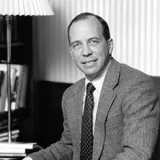
George H. Davis was inaugurated as the twenty-second president of The University of Vermont on October 26, 1990. A forty-seven-year-old native of Pittsburgh, Davis received his bachelor’s degree from the College of Wooster, his master’s from the University of Texas at Austin, and his doctorate in structural geology from the University of Michigan. Prior to coming to Vermont, Davis had served as the interim vice president for business affairs and the former chair of the Department of Geosciences at the University of Arizona.
His inauguration marked the start of the year-long UVM bicentennial celebration, which was scheduled to culminate in the university’s two-hundredth birthday on November 3, 1991. In his inaugural address, President Davis expressed “optimism and confidence” as he announced progress on a major capital campaign with a final goal of $100 million. Despite his expression of enthusiasm, however, the university faced a heavy array of difficult challenges.
The first involved a deepening financial crisis. During the early 1990’s, the entire New England region was mired in a difficult recession. The weak economy had a negative impact on state funding, and it placed considerable economic pressure on the university. As a result, Davis was forced to institute a temporary hiring freeze, and he launched a major, long-range strategic planning process in an effort to set future priorities which would result in reductions in UVM’s budget.
A second complex challenge related to the issue of diversity. In April 1988, Lattie F. Coor had signed the “Waterman Agreement” before he left to take on his new post as president of Arizona State University. This agreement included more than a dozen ambitious goals designed to increase the number of multicultural students and faculty members at UVM, as well as to improve awareness of racial issues. By the time Davis arrived in 1990, only minimal progress had been made in reaching these goals, and he was faced with the immediate task of moving ahead rapidly and aggressively.
Finally, President Davis and his wife, Merrily, were complete newcomers to Vermont, and they both had to spend considerable time learning about the university and the state. To their credit, during the summer of 1990, they visited all fourteen of Vermont’s counties and met well over a thousand UVM alumni. There is little doubt, however, that the UVM agenda was heavily overcrowded when the Davis family arrived in Burlington.
The first signs of trouble broke out in April 1991, when a group of students, unsatisfied with the slow pace of action on the diversity issue, began a twenty-day occupation of the president’s office in Waterman. After the occupation ended in May with the arrest of eight students and one faculty member, the protesters moved their headquarters to the UVM green where they hastily constructed a cluster of shanties which they named “Diversity University.” In July 1991, Dalmas Taylor, a fifty-seven-year-old African-American educator who had served as dean of the School of Liberal Arts at Detroit’s Wayne State University, came to Burlington as UVM’s new provost, and he quickly began work to formulate a comprehensive plan for cultural diversity.
At the same time, the strategic planning process designed to reduce UVM’s financial deficit was moving ahead rapidly. In the fall of 1991, the Strategic Planning Council released its preliminary draft report to the faculty and other interested parties for the purpose of discussion. Among the council’s suggestions was a proposal to eliminate the College of Mathematics and Engineering, as well as several graduate programs.
Many faculty members expressed angry dissatisfaction with the report, and the proposals came under heavy attack in a stormy meeting of the Faculty Senate held on October 16. At this point, events deteriorated extremely rapidly. The next day forty of the forty-four members attending an Arts and Sciences faculty meeting also attacked the report and rejected the preliminary proposals of the council. President Davis, totally frustrated and dispirited, submitted a letter of resignation to the board of trustees on October 21, expressing regret that “support for my leadership is not sufficiently strong for me to carry on.”
Although George Davis had only served as president of the university for a year, his resignation was not unique. His departure took place shortly after the presidents of three other Vermont institutions — Middlebury College, Johnson State College, and Norwich University — had announced their own plans to resign. In retrospect, the poor economy, coupled with the pressures of the job, placed tremendous strains on many of the state’s higher education leaders during the early 1990’s.